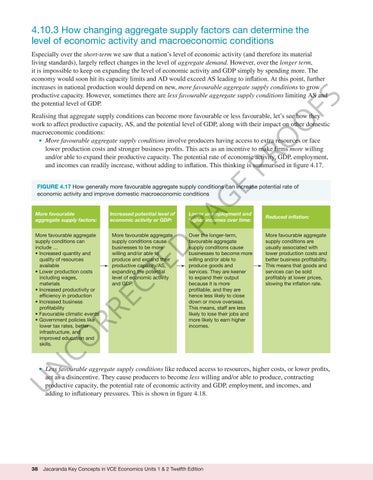“c04EconomicActivity_PrintPDF” — 2022/5/28 — 13:00 — page 38 — #38
4.10.3 How changing aggregate supply factors can determine the level of economic activity and macroeconomic conditions
FS
Especially over the short-term we saw that a nation’s level of economic activity (and therefore its material living standards), largely reflect changes in the level of aggregate demand. However, over the longer term, it is impossible to keep on expanding the level of economic activity and GDP simply by spending more. The economy would soon hit its capacity limits and AD would exceed AS leading to inflation. At this point, further increases in national production would depend on new, more favourable aggregate supply conditions to grow productive capacity. However, sometimes there are less favourable aggregate supply conditions limiting AS and the potential level of GDP.
E
PR
O
O
Realising that aggregate supply conditions can become more favourable or less favourable, let’s see how they work to affect productive capacity, AS, and the potential level of GDP, along with their impact on other domestic macroeconomic conditions: • More favourable aggregate supply conditions involve producers having access to extra resources or face lower production costs and stronger business profits. This acts as an incentive to make firms more willing and/or able to expand their productive capacity. The potential rate of economic activity, GDP, employment, and incomes can readily increase, without adding to inflation. This thinking is summarised in figure 4.17.
PA
G
FIGURE 4.17 How generally more favourable aggregate supply conditions can increase potential rate of economic activity and improve domestic macroeconomic conditions
Increased potential level of economic activity or GDP:
Lower unemployment and higher incomes over time:
More favourable aggregate supply conditions can include … • Increased quantity and quality of resources available • Lower production costs including wages, materials • Increased productivity or efficiency in production • Increased business profitability • Favourable climatic events • Government policies like lower tax rates, better infrastructure, and improved education and skills.
More favourable aggregate supply conditions cause businesses to be more willing and/or able to produce and expand their productive capacity/AS, expanding the potential level of economic activity and GDP.
Over the longer-term, favourable aggregate supply conditions cause businesses to become more willing and/or able to produce goods and services. They are keener to expand their output because it is more profitable, and they are hence less likely to close down or move overseas. This means, staff are less likely to lose their jobs and more likely to earn higher incomes.
N
CO RR EC
TE
D
More favourable aggregate supply factors:
Reduced inflation:
More favourable aggregate supply conditions are usually associated with lower production costs and better business profitability. This means that goods and services can be sold profitably at lower prices, slowing the inflation rate.
• Less favourable aggregate supply conditions like reduced access to resources, higher costs, or lower profits,
U
act as a disincentive. They cause producers to become less willing and/or able to produce, contracting productive capacity, the potential rate of economic activity and GDP, employment, and incomes, and adding to inflationary pressures. This is shown in figure 4.18.
38
Jacaranda Key Concepts in VCE Economics Units 1 & 2 Twelfth Edition





















































